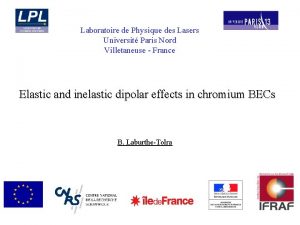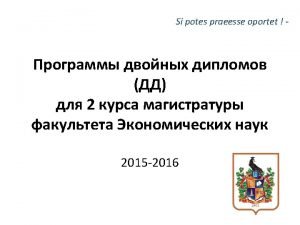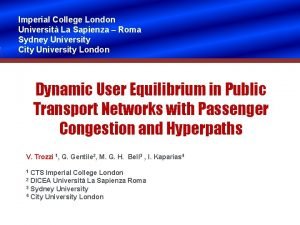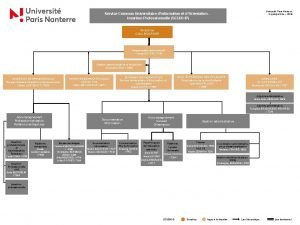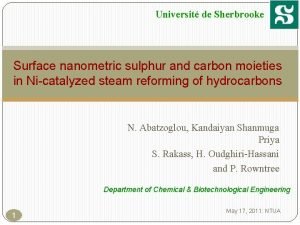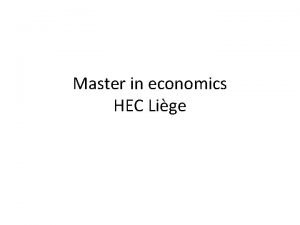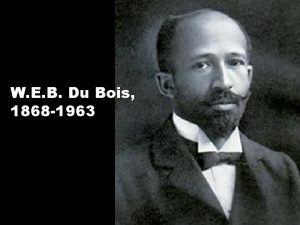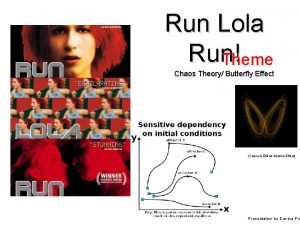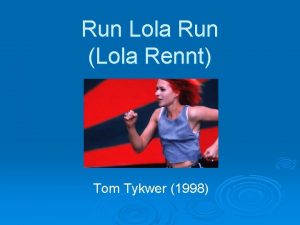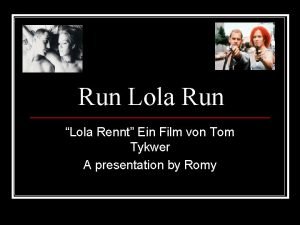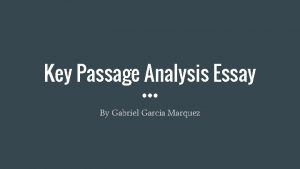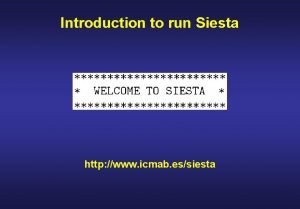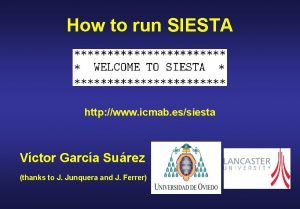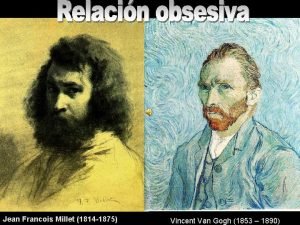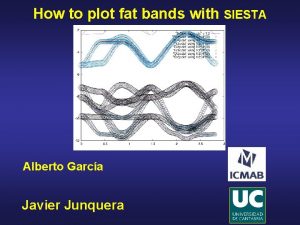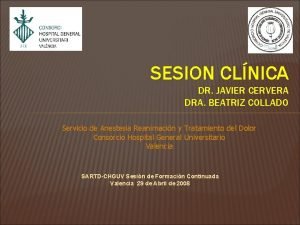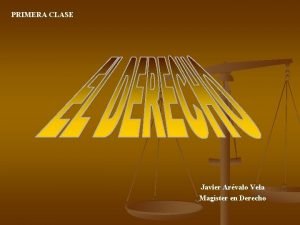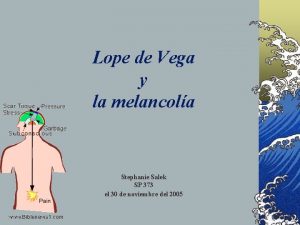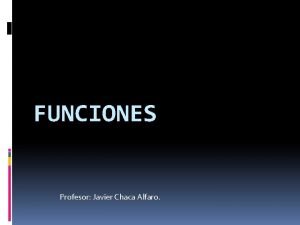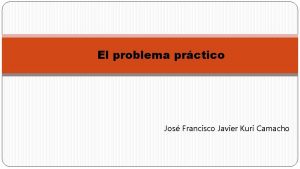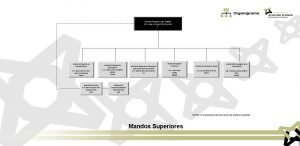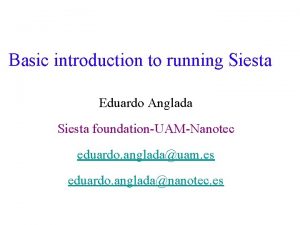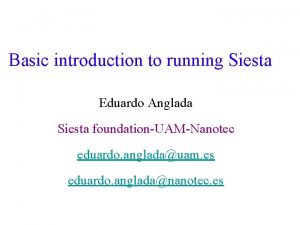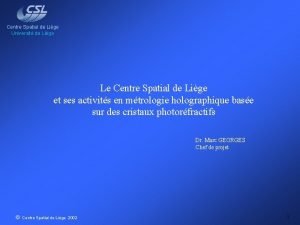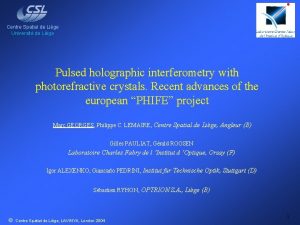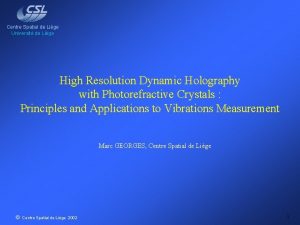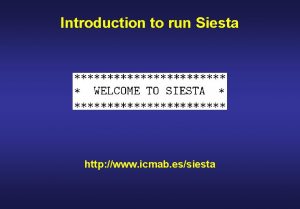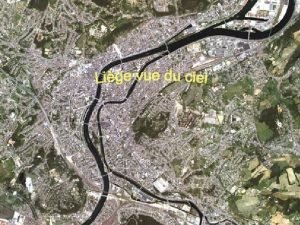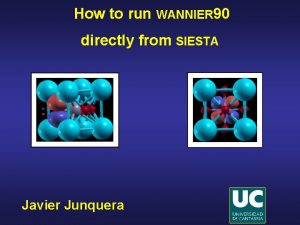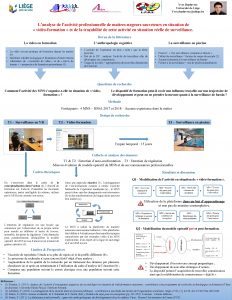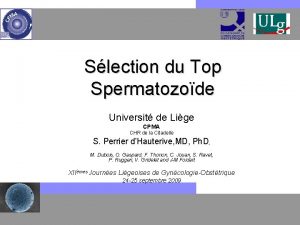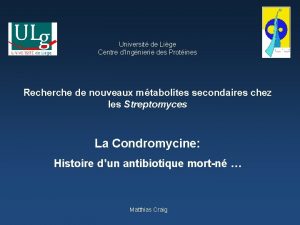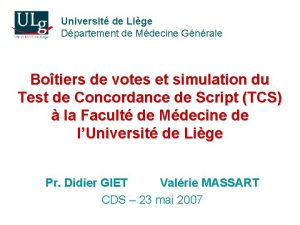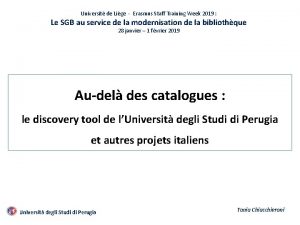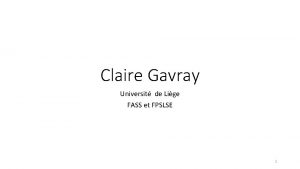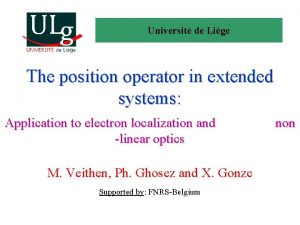Universit de Lige Introduction to run Siesta Javier



















![How to run Siesta To run the serial version: [path]siesta < myinput. fdf > How to run Siesta To run the serial version: [path]siesta < myinput. fdf >](https://slidetodoc.com/presentation_image_h/1ec4177df04d43d2fe20954da9ebff3d/image-20.jpg)
















- Slides: 36

Université de Liège Introduction to run Siesta Javier Junquera

Our method Linear-scaling DFT based on NAOs (Numerical Atomic Orbitals) P. Ordejon, E. Artacho & J. M. Soler , Phys. Rev. B 53, R 10441 (1996) J. M. Soler et al, J. Phys. : Condens. Matter 14, 2745 (2002) • Born-Oppenheimer (relaxations, mol. dynamics) • DFT (LDA, GGA) • Pseudopotentials (norm conserving, factorised) • Numerical atomic orbitals as basis (finite range) • Numerical evaluation of matrix elements (3 Dgrid) Implemented in the SIESTA program D. Sanchez-Portal, P. Ordejon, E. Artacho & J. M. Soler Int. J. Quantum Chem. 65, 453 (1997)

To run Siesta you need: 1. - Access to the executable file 2. - An input file Flexible Data Format (FDF) (A. García and J. M. Soler) 3. - A pseudopotential file for each kind of element in the input file Unformatted binary (. vps) Formatted ASCII (. psf) (more transportable and easy to look at)

Siesta package: • Src: Sources of the Siesta code • Docs: Documentation and user conditions User’s Guide (siesta. tex) • Pseudo: ATOM program to generate and test pseudos (A. García; Pseudopotential and basis generation, Tu 12: 00) • Examples: fdf and pseudopotentials input files for simple systems • Utils: Programs or scripts to analyze the results

The input file Main input file: • Physical data of the system • Variables to control the approximations • Flexible Data Format (FDF) developped by A. García and J. M. Soler

FDF (I) • Data can be given in any order • Data can be omitted in favour of default values • Syntax: ‘data label’ followed by its value Character string: System. Label h 2 o Integer: Number. Of. Atoms 3 Real: PAO. Split. Norm 0. 15 Logical: Spin. Polarized . false. Physical magnitudes Lattice. Constant 5. 43 Ang

FDF (II) • Labels are case insensitive and characters -_. are ignored Lattice. Constant is equivalent to lattice_constant • Text following # are comments • Logical values: T , . true. , true , yes F , . false. , false , no • Character strings, NOT in apostrophes • Complex data structures: blocks %block label … %endblock label

FDF (III) • Physical magnitudes: followed by its units. Many physical units are recognized for each magnitude (Length: m, cm, nm, Ang, bohr) Automatic conversion to the ones internally required. • You may ‘include’ other FDF files or redirect the search to another file

Basic input variables 1. - General system descriptors 2. - Structural and geometrical variables 3. - Functional and solution mehod 4. - Convergence of the results 5. - Self-consistency (Basis set generation related variables: A. García; Pseudopotential and basis generation, Tu 12: 00)

General system descriptor System. Name: descriptive name of the system System. Name Si bulk, diamond structure System. Label: nickname of the system to name output files System. Label Si (After a succesful run, you should have files like Si. DM : Density matrix Si. XV: Final positions and velocities. . . )

Structural and geometrical variables Number. Of. Atoms: number of atoms in the simulation Number. Of. Atoms 2 Number. Of. Species: number of different atomic species Number. Of. Species 1 Chemical. Species. Label: specify the different chemical species. %block Chemical. Species. Label 1 14 Si %endblock Chemical. Species. Label ALL THESE VARIABLES ARE MANDATORY

Periodic Boundary Conditions (PBC) Atoms in the unit cell are periodically repeated throughout space along the lattice vectors Periodic systems and crystalline solids: Aperiodic systems: Supercell approximation Defects Molecules Surfaces M. C. Payne et al, Rev. Mod. Phys. , 64, 1045 (92)

Lattice Vectors Lattice. Constant: real length to define the scale of the lattice vectors Lattice. Constant 5. 43 Ang Lattice. Parameters: Crystallograhic way %block Lattice. Parameters 1. 0 60. 60. %endblock Lattice. Parameters Lattice. Vectors: read as a matrix, each vector being a line %block Lattice. Vectors 0. 0 0. 5 0. 0 %endblock Lattice. Vectors

Atomic Coordinates Atomic. Coordinates. Format: format of the atomic positions in input: Bohr: cartesian coordinates, in bohrs Ang: cartesian coordinates, in Angstroms Scaled. Cartesian: cartesian coordinates, units of the lattice constant Fractional: referred to the lattice vectors Atomic. Coordinates. Format Fractional Atomic. Coordinates. And. Atomic. Species: %block Atomic. Coordinates. And. Atomic. Species 0. 00 1 0. 25 1 %endblock Atomic. Coordinates. And. Atomic. Species

Functional DFT XC. Functional XC. authors LDA CA GGA PW 92 PBE PZ Spin. Polarized CA Ceperley-Alder DFT Density Functional Theory PZ Perdew-Zunger LDA Local Density Approximation PW 92 Perdew-Wang-92 GGA Generalized Gradient Approximation PBE Perdew-Burke-Ernzerhof

Solution method From the atomic coordinates and the unit cell Order N operations Hamiltonian, H, and Overlap, S, matrices Solution. Method diagon Order-N E. Artacho, Running with Order-N, Wed 11: 40

k-sampling Many magnitudes require integration of Bloch functions over Brillouin zone (BZ) In practice: integral sum over a finite uniform grid Essential for: Small systems Metals Magnetic systems Good description of the Bloch states at the Fermi level Even in same insulators: Perovskite oxides Real space Reciprocal space

k-sampling Spetial set of k-points: Accurate results for a small # k-points: Baldereschi, Chadi-Cohen, Monkhorst-Pack kgrid_cutoff: kgrid_cutoff 10. 0 Ang kgrid_Monkhorst_Pack: %block kgrid_Monkhorst_Pack 4 0 0 0. 5 4 0 0. 5 5 0 0 4 0. 5 %endblock kgrid_Monkhorst_Pack

Initial guess Mixing Linear: DM. Mixing. Weigth Non. Linear (Pulay): DM. Number. Pulay Self-consistent iterations Max. SCFIterations DM. Tolerance Total energy Charge density Forces
![How to run Siesta To run the serial version pathsiesta myinput fdf How to run Siesta To run the serial version: [path]siesta < myinput. fdf >](https://slidetodoc.com/presentation_image_h/1ec4177df04d43d2fe20954da9ebff3d/image-20.jpg)
How to run Siesta To run the serial version: [path]siesta < myinput. fdf > myoutput & To see the information dumped in the output file during the run: tail –f myoutput

Output: the header

Output: dumping the input file

Output: processing the input

Output: coordinates and k-sampling

Output: First MD step

Output: Self-consistency

Output: Eigenvalues, forces, stress

Output: Total energy

Output: timer

Saving and reading information (I) Some information is stored by Siesta to restart simulations from: • Density matrix: DM. Use. Save. DM • Localized wave functions (Order-N): ON. Use. Save. LWF • Atomic positions and velocities: MD. Use. Save. XV • Conjugent gradient history (minimizations): MD. Use. Save. CG All of them are logical variables EXTREMLY USEFUL TO SAVE LOT OF TIME!

Saving and reading information (II) Information needed as input for various post-processing programs, for example, to visualize: • Total charge density: Save. Rho • Deformation charge density: Save. Delta. Rho • Electrostatic potential: Save. Electrostatic. Potential • Total potential: Save. Total. Potential • Local density of states: Local. Density. Of. States • Charge density contours: Write. Denchar • Atomic coordinates: Write. Coor. Xmol and Write. Coor. Cerius All of them are logical variables

Analyzing the electronic structure (I) • Band structure along the high symetry lines of the BZ Band. Line. Scale: scale of the k vectors in Band. Lines Band. Line. Scale pi/a Band. Lines: lines along with band energies are calculated. %block Band. Lines 1 1. 000 L 20 0. 000 Gamma 25 2. 000 0. 000 X 30 2. 000 Gamma %endblock Band. Lines

Analyzing the electronic structure (II) • Density of states: total and projected on the atomic orbitals - Compare with experimental spectroscopy - Bond formation - Defined as: Projected. Density. Of. States: %block Projected. Density. Of. States -20. 00 10. 00 0. 200 500 e. V %endblock Projected. Density. Of. States

Analyzing the electronic structure (III) • Population analysis: Mulliken prescription - Amounts of charge on an atom or in an orbital inside the atom - Bond formation - Be careful, very dependent on the basis functions Write. Mulliken. Pop 0 = None 1 = Atomic and orbitals charges 2 = 1 + atomic overlap pop. 3 = 2 + orbital overlap pop.

Tools (I) • Various post-processing programs: -PHONONS: -Finite differences: VIBRA (P. Ordejón) -Linear response: LINRES ( J. M. Alons-Pruneda et al. ) -Interphase with Phonon program (Parlinsky) -Visualize of the CHARGE DENSITY and POTENTIALS -3 D: PLRHO (J. M. Soler) -2 D: CONTOUR (E. Artacho) -2 D: DENCHAR (J. Junquera)

Tools (II) -TRANSPORT PROPERTIES: -TRANSIESTA (M. Brandbydge et al. ) -PSEUDOPOTENTIAL and BASIS information: -Py. Atom (A. García) -ATOMIC COORDINATES: -Sies 2 arc (J. Gale)
 Universit
Universit Erasmus school of economics
Erasmus school of economics London universit
London universit Julien pothet
Julien pothet Universit sherbrooke
Universit sherbrooke Lige daniels
Lige daniels Jeux en lige
Jeux en lige Master lige
Master lige Lige daniels
Lige daniels Short run equilibrium under perfect competition
Short run equilibrium under perfect competition Run lola run theme
Run lola run theme Run lola run editing techniques
Run lola run editing techniques Short run vs long run economics
Short run vs long run economics Within run and across run meaning
Within run and across run meaning Long run profit in perfect competition
Long run profit in perfect competition Run lola run script
Run lola run script Lolas nn
Lolas nn Analisis la siesta del martes
Analisis la siesta del martes La siesta del martes analysis
La siesta del martes analysis What is a passage analysis
What is a passage analysis Siesta icmab
Siesta icmab Siesta lean to
Siesta lean to La siesta del martes siglo
La siesta del martes siglo Jean van gogh
Jean van gogh Alberto la siesta
Alberto la siesta Javier arvalo
Javier arvalo Javier navaridas
Javier navaridas Javier remiro
Javier remiro Dr. javier collado
Dr. javier collado Javier arvalo
Javier arvalo Dr. javier e. calvo
Dr. javier e. calvo Javier salek
Javier salek Encontrar el dominio y rango de la funcion y=x2
Encontrar el dominio y rango de la funcion y=x2 Dr. francisco javier kuri con
Dr. francisco javier kuri con Javier canillas
Javier canillas Francisco javier salazar silva
Francisco javier salazar silva Justin trudeau antichrist
Justin trudeau antichrist
